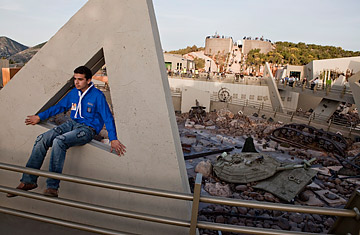
A young member of Hizbollah's Mahdi Scouts sits on the edge of "the abyss," an exhibit of captured Israeli tanks and armored vehicles, part of Hizbollah's Mleeta "resistance tourism" Museum in Mleeta, Lebanon.
The rocky red hills and dense oak forests of southern Lebanon near the Israeli border make perfect terrain for guerrilla warfare, as the Israeli army has repeatedly discovered to its chagrin. Whether or not the once and future war zone is an ideal location for a multi-million dollar tourist attraction is another matter. But that hasn't stopped Hizballah, the anti-Israeli militant group and Shi'ite Muslim political party, from opening a war memorial this summer here in the southern hill town of Mleeta. With a reported cost of about $20 million and a cryptic slogan ("Earth Speaks to Heaven"), Mleeta is the first stage of what Hizballah hopes will be a kind of family theme park of the Islamic Resistance that will eventually include spa hotels, a paint-ball gun battlefield, and a cable-car ride with a scenic view of northern Israel, or as the tour guides call it, "Occupied Palestine."
Mleeta is a full-frontal display of the Party of God's legendary attention to detail, its willingness to sacrifice, and its glorification of combat. Visitors walk down "The Path" — a winding trail interspersed with mannequin-filled dioramas of combat scenes, including a field hospital and a camouflaged rocket launch site meant to convey the experience of being a mujaheddin. They duck their heads and enter "The Cave" — a once-secret bunker used as barracks for as many as 7,000 militants that engineers carved out of the hillside over a period of several years, scattering its debris for miles to avoid drawing the attention of Israeli reconnaissance planes. And they can gawk at "The Abyss," a pit filled with captured Israeli machine guns, rockets and tanks. "These arms were used to destroy your homes, look at them now under your feet," said a tour guide recently to a busload of men in Hizballah canary yellow baseball caps and women in black chadors visiting from the Martyr's Association, a charity for the families of militants killed in action. "Every helmet you are seeing is from a dead Israeli soldier," he said.
So far, Mleeta is a hit among the ranks of the Hizballah faithful. "When I see such achievements, I forget the blood of my son,'" says Ahmad Sleim, 70, a farmer visiting Mleeta and the father of 13 sons, all of whom were Hizballah militants, and one of whom died in 1992 fighting in the south. "This is holy ground," he says. There may even be a broader audience: some adventurous European tourists have asked about Mleeta, envisioning it as a radical-chic way to see the Arab-Israeli conflict close-up. But the very existence of Mleeta — which was two years and some 50 architects and engineers in the making — is also a sign of an organization in the midst of an identity crisis.
Since its creation in 1982 to resist the Israeli invasion of Lebanon, Hizballah's guerrilla organization has always been most comfortable living in the shadows — and shadowy guerrilla groups don't usually build permanent museums with their own websites: www.mleeta.com. But Hizballah's main source of legitimacy — the liberation of southern Lebanon from Israeli occupation back in 2000 — is getting a little stale. Its recent military achievements — such as standing down the Israeli army during the summer of 2006 — have been mixed blessings to those Lebanese who complain that Hizballah started the war in the first place by kidnapping Israeli soldiers. Since then Hizballah has been in the uncomfortable position of having to justify its continued existence as an armed military force separate from the Lebanese government. That debate took a violent turn when Hizballah used its weapons on its rivals in the streets of Beirut in 2008, and negotiated a deal whereby it would have a veto power over any attempt by the Lebanese government to disarm it.
So now Hizballah is in public relations overdrive to repair the damage to its reputation caused by that internal Lebanese political battle. On the one hand, the Mleeta museum reminds the Lebanese that they owe their freedom from Israeli occupation to Hizballah. On the other hand, now that the occupation is over, Hizballah is also trying to re-brand itself as a "deterrence" organization (as opposed to one of "resistance) so that it can keep its rockets to make sure Israel doesn't come back. Mleeta is part of that rebranding: a display in one of its galleries lists the sites in Israel — Ben Gurion airport in Tel Aviv, the nuclear reactor at Dimona, hotels in Elat, etc. — that Hizballah would target in response to an Israeli attack.
But plenty of Lebanese are worried that Hizballah's arsenal — Israel claims that Hizballah has re-armed with more rockets and better military technology since the 2006 war — makes another war with Israel that much more likely. A war almost broke out this spring, when U.S. officials accused Syria of training Hizballah with the use of ballistic Scud missiles.
Indeed given that officials from both sides say they expect another war within a year or so, there is something either vain or stoic about building a war memorial that will almost certainly be destroyed by the Israeli air force. "We'll just re-build all over again," says one Hizballah official. But whether other Lebanese will be so gung-ho when the dust settles remains to be seen.
.